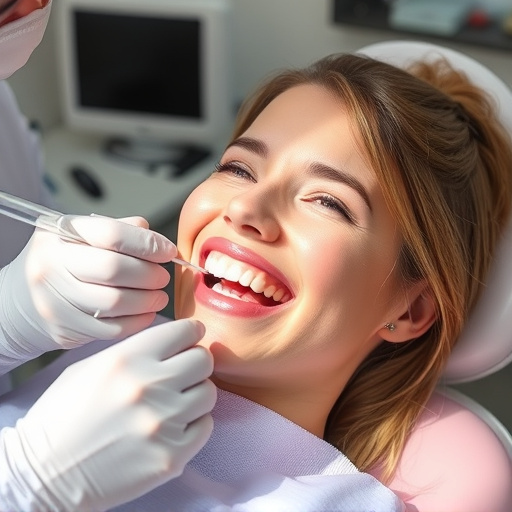TMJ Disorder Treatment: Pain-Free Living Through Understanding and Changes
TMJ disorder treatment involves addressing a complex condition with various causes, from injuries an…….
TMJ (Temporomandibular Joint) disorder, a complex condition affecting the jaw joint and surrounding muscles, has become an increasingly recognized health concern worldwide. This article delves into the multifaceted world of TMJ disorder treatment, exploring its various approaches, global impact, economic implications, and future potential. By examining these aspects, we aim to provide a holistic understanding of how this treatment field is evolving and improving the lives of those affected by TMJ disorders.
Definition: TMJ disorder treatment refers to a range of interventions designed to manage and alleviate symptoms associated with Temporomandibular Joint Disorder (TMJD). TMJD is a common condition characterized by pain in the temporomandibular joint, which connects the jawbone to the skull. This disorder can result from various factors, including muscle tension, joint inflammation, disc displacement, or degenerative changes.
Core Components: The treatment for TMJ disorders typically involves a multidisciplinary approach, combining medical, surgical, and non-invasive therapies. Non-surgical treatments often include:
Surgical interventions may be considered for severe cases or when non-surgical treatments have been ineffective. These include arthroscopic surgery, joint replacement, or open-joint surgery.
Historical Context: The understanding and treatment of TMJD have evolved significantly over the past few decades. Historically, surgical treatments dominated the field, often involving complex procedures with lengthy recovery times. However, advancements in medical knowledge and technology have led to a more nuanced approach, emphasizing non-invasive and conservative management strategies.
TMJ disorder treatment has gained international recognition, with varying levels of adoption and emphasis across different regions:
| Region | Approach | Key Trends |
|---|---|---|
| North America | Highly advanced, with a strong focus on evidence-based medicine. Many leading research institutions contribute to global TMJ disorder treatment guidelines. | Personalized treatment plans, combining advanced imaging and precise diagnostics. Growing use of botulinum toxin (Botox) for muscle relaxation. |
| Europe | Comprehensive, integrating both conventional and alternative therapies. Stresses patient education and lifestyle modifications. | Increasing adoption of digital occlusal analysis and personalized mouth guard therapy. Rising interest in platelet-rich plasma (PRP) injections. |
| Asia | Balances traditional and modern approaches, with a focus on holistic health. Acupuncture and herbal remedies are commonly used alongside Western treatments. | Growing demand for TMJ disorder treatment due to rising awareness and improving healthcare infrastructure. Integration of TMJ management into general dental practices. |
| Latin America | Variability in access to care, with urban areas offering more advanced options. A mix of public and private healthcare systems influences treatment availability. | Increasing interest in telemedicine for remote consultations and monitoring. Community-based programs promoting oral health education. |
| Middle East & Africa | Relatively lower awareness and access to specialized care. Focus on basic dental care and pain management. | Growing investment in healthcare infrastructure, leading to improved TMJ disorder treatment options. Training initiatives for dental professionals. |
The economic landscape of TMJ disorder treatment is influenced by several factors:
Technological innovations have revolutionized TMJ disorder treatment:
Regulatory frameworks play a critical role in ensuring the safety and effectiveness of TMJ disorder treatments:
Despite significant progress, TMJ disorder treatment faces several challenges:
Strategies for Overcoming Challenges:
Background: A 32-year-old female patient presented with chronic TMJD, experiencing severe pain and limited jaw mobility. Conventional treatments had provided only temporary relief.
Treatment: She was enrolled in a clinical trial investigating a novel non-surgical therapy combining platelet-rich plasma (PRP) injections and targeted physical therapy. PRP, rich in growth factors, promotes tissue repair and reduces inflammation.
Outcomes: After 12 weeks of treatment, the patient reported a significant reduction in pain levels and improved jaw function. Follow-up imaging showed signs of joint remodeling, indicating successful regeneration of TMJ soft tissues. This case highlights the potential of PRP therapy as a game-changer for non-surgical TMJD management.
Scenario: A 55-year-old male patient underwent arthroscopic surgery to repair a damaged TMJ disc and stabilize the joint. Post-surgery, he required extensive rehabilitation to regain jaw function and prevent scar tissue formation.
Intervention: A multidisciplinary rehabilitation program was implemented, encompassing physical therapy, occlusal splint use, and oral exercises. The team also utilized advanced speech analysis and jaw tracking technology to monitor progress and adjust the treatment plan.
Results: Within 6 months, the patient regained nearly full jaw mobility and experienced substantial pain reduction. Speech clarity improved significantly, and he was able to return to his regular activities without restrictions. This case study underscores the importance of comprehensive post-operative care in achieving optimal surgical outcomes.
The future of TMJ disorder treatment holds immense potential for advancements:
TMJ disorder treatment is a dynamic field that continues to evolve, offering hope and improved quality of life for those affected by TMJD. From advanced imaging techniques to innovative therapies, the global community’s collective efforts have led to significant progress. As research progresses and technological barriers are broken, the future looks bright for individuals seeking relief from TMJ disorders.
Q: What are the common symptoms of TMJ disorder?
A: Common symptoms include jaw pain, chewing difficulty, popping or clicking sounds in the joint, limited mouth opening, and headaches.
Q: How is TMJ disorder diagnosed?
A: Diagnosis involves a comprehensive clinical evaluation, including medical history, physical examination, and advanced imaging studies like MRI or CT scans.
Q: Are there any home remedies for TMJ pain?
A: Yes, some effective home remedies include applying heat or ice packs, practicing gentle jaw stretches, maintaining proper posture, and avoiding hard or sticky foods.
Q: Is surgery always necessary for TMJ disorder treatment?
A: No, surgery is typically a last resort. Many patients find relief through non-surgical treatments, such as physical therapy, mouth guards, and medication.
Q: How can I choose the right mouth guard for TMJ disorder?
A: Custom-fitted mouth guards are ideal. Consult your dentist or healthcare provider to ensure a precise fit and consider advanced features like occlusal analysis and bite adjustment.

TMJ disorder treatment involves addressing a complex condition with various causes, from injuries an…….